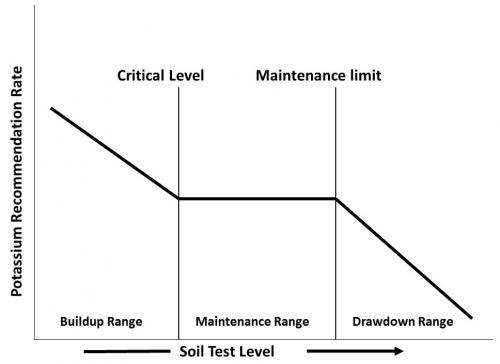Potassium fertilizer management strategies
Tips for managing potassium fertilizer applications in your crops to protect your 2016 profit.
Average corn and soybean market prices for the 2016 to 2017 marketing year are expected to be near or below the breakeven prices for these crops when land cost is included. Because of this, producers will need to manage fertilizer costs carefully. The following are Michigan State University Extension’s recommendations for managing potassium fertilizer.
Test your soils and set realistic yield goals
Collect representative soil samples considering soil type, topography and past management. To determine a realistic yield goal, look at the yields for the past five years the crop was planted in the field and take the average after subtracting out the highest and the lowest yields.
Understand MSU’s potassium recommendation scheme
In the build-up range, nutrient recommendations exceed crop removal rates until the critical level is attained. Once the potassium soil test level has reached the critical level, the soil is capable of providing enough potassium to produce 95 to 97 percent of the maximum yield. Between the critical level and the drawdown level (maintenance range), nutrient recommendations are equal to crop removal rates. The maintenance range is 30 parts per million (ppm) for most crops. When soil test levels exceed the drawdown level, nutrient recommendations are less than crop removal rates.

MSU potassium recommendation scheme
Know the critical soil test levels for potassium and how these are affected by cation exchange capacity (CEC)
The critical soil test level for potassium is easily calculated using the following formula: Critical Level = (CEC x 2.5) + 75
|
Effect of CEC on potassium (K) critical soil test levels |
|
|---|---|
|
CEC (meq/100g) |
Critical K soil test level |
|
4 |
85 |
|
6 |
90 |
|
8 |
95 |
|
10 |
100 |
|
12 |
105 |
Know K2O crop removal rates
Crops vary in how much potash they remove from the soil. Simply multiply the removal rate by your yield goal to determine the potassium maintenance application rate for your fields.
|
K2O removal rates for various crops |
|
|---|---|
|
Crop |
K2O removal rate |
|
Corn |
0.27 pounds per bushel |
|
Soybeans |
1.4 pounds per bushel |
|
Wheat |
0.37 pounds per bushel |
|
Alfalfa |
50 pounds per ton |
Predict how your potassium fertilizer decisions will affect crop yields and future potassium soil test levels
Remember that the critical soil test levels are high enough to produce 95 to 97 percent of the maximum yield for the soil type. Potassium fertilizer applications will increase yields by only 3 to 5 percent when potassium soil test levels are above the critical level. To determine how potassium soil test levels will change, you should consider that crops must remove 8 pounds per acre of K2O in coarse-textured soils, 14 pounds per acre in medium-textured soils and 20 pounds in fine-textured soils to reduce the potassium soil test level by 1 ppm. You must add these same quantities plus crop removal rates to increase soil test levels by 1 ppm.
How much will my potassium soil test levels change if I decide not to add potassium fertilizer to a medium-textured soil this year?
- For 190 bushels of corn per acre:
- 190 bushels x 0.27 pounds per acre = 51.3 pounds K2O per acre removed by the crop.
- Remember 14 pounds of K2O per acre must be removed to reduce the soil test by 1 ppm.
- 51.3 ÷ 14 = 3.7 ppm
- For 60 bushels of soybeans per acre:
- 60 bushels x 1.4 pounds K2O per acre = 84 pounds K2O per acre removed by the crop.
- 84 ÷ 14 = 6 ppm
Subtract these amounts from your existing soil test levels to determine how your soil test levels will change.
Determine where your potassium soil test levels are in relation to the critical levels and estimate how your potassium soil test levels will be affected by your potash management decisions
Use this information and the law of diminishing returns to allocate potassium fertilizer this season.
This article was produced by the SMaRT project (Soybean Management and Research Technology). The SMaRT project was developed to help Michigan producers increase soybean yields and farm profitability. The SMaRT project is a partnership between MSU Extension and the Michigan Soybean Promotion Committee.



 Print
Print Email
Email



